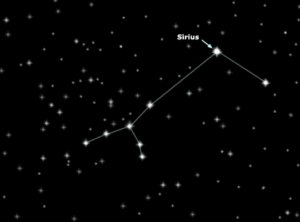 The other night I waited in the “cell-phone lot” at the airport for someone arriving. The lot is out in a grassy field some distance from the airport, which is itself way south of the city. So I leaned the car seat back and opened the sun roof (moon roof?) and looked up.
The other night I waited in the “cell-phone lot” at the airport for someone arriving. The lot is out in a grassy field some distance from the airport, which is itself way south of the city. So I leaned the car seat back and opened the sun roof (moon roof?) and looked up.
To my amazement, the sky was full of stars. I hadn’t seen stars in about three years. When you live in a city, you don’t. When I happen to be out in the country at night, I don’t notice the sky because I’m busy – driving, usually. I don’t hang out in grassy fields with time to stare at stars.
My first reaction was, “WTF?” I knew the stars were there, of course. But after so many years, I had forgotten. And so many stars! Is that really necessary? How long has this been going on? Who else knows about it? Those were my initial thoughts.
I’m relatively up to date on popular astronomy and cosmology. I’m accustomed to studying a photograph of fuzzy blotches on a black field, galaxies and stars, typically with a yellow arrow pointing out some particular fuzzy blotch of interest. None of the scientific literature has anything to do with the visceral shock of seeing the actual sky covered in blinking lights.
 In particular I noticed a large bright star, blue-green, above the southwest horizon. When I got home I looked it up and deduced it was probably Sirius, the Dog Star. It’s nearly nine light years away. How big would a nuclear fusion reaction (a thermonuclear bomb) have to be for the explosion to be visible 54 trillion miles away? Big, very big.
In particular I noticed a large bright star, blue-green, above the southwest horizon. When I got home I looked it up and deduced it was probably Sirius, the Dog Star. It’s nearly nine light years away. How big would a nuclear fusion reaction (a thermonuclear bomb) have to be for the explosion to be visible 54 trillion miles away? Big, very big.
After that moment of shock and awe, I started thinking about what I was looking at. I knew that many of the “stars” I was seeing were probably galaxies full of billions of stars. Among those uncountable suns, there were even more uncountable planets. Statistically, a very large number of them would be suitable for life. The aliens are definitely out there, no question about it.
In answer to Fermi’s famous question upon looking at the stars, “Where is everybody?” I would say, “Right in front of your eyes.” What we have is a communication problem.
 Timing is the biggest obstacle to communication with aliens. We humans have only been suitably conscious of the possibility of extraterrestrial communication for a few hundred years, since the scientific revolution around 1600. That amount of time is an immeasurably small blip on the scale of the cosmos. We haven’t been “taking calls” long enough to catch any. We could have already missed hundreds or thousands of them. And we have no voice mail.
Timing is the biggest obstacle to communication with aliens. We humans have only been suitably conscious of the possibility of extraterrestrial communication for a few hundred years, since the scientific revolution around 1600. That amount of time is an immeasurably small blip on the scale of the cosmos. We haven’t been “taking calls” long enough to catch any. We could have already missed hundreds or thousands of them. And we have no voice mail.
Beyond the timing issue however, what form would an extraterrestrial communication take, and in what medium, at what frequency? Lotta questions.
And what does “communication” even mean? We presume there would be a sender, a receiver, a channel, and a message. But why would that have to be true? That’s just the way we conceptualize things. Doesn’t make it a law of the universe.
In one of my recent novels (yet unpublished), the alien’s message comes from within. Our SETI telescopes are pointed the wrong way. Actually, we don’t even need any telescopes.
And then there is the question of the message. What is a message? How do we distinguish a message from a context of flux? Is the sound of a babbling brook a message? I think not, because none of the elements of a babbling brook are capable of intentionality. But that assumes a lot, about “elements,” signals and noise, and intentionality.
And then I began thinking about what kind of a mind an alien would need to have in order to communicate. Assuming there are “minds,” which I do, and assuming one is necessary as the source of intentionality, which I believe is the foundation of communication.
 I’m not talking about brains here. Aliens don’t need brains. They don’t need any biology. I’m not assuming “life as we know it.” I’m agnostic about the nature of alien embodiment. I rather think a mind must be embodied, but that’s not a requirement. In any case, the “body” could be a bacterium, a rock, a gas ball, a fusion reaction, or a magnetic field. It’s an implementation detail.
I’m not talking about brains here. Aliens don’t need brains. They don’t need any biology. I’m not assuming “life as we know it.” I’m agnostic about the nature of alien embodiment. I rather think a mind must be embodied, but that’s not a requirement. In any case, the “body” could be a bacterium, a rock, a gas ball, a fusion reaction, or a magnetic field. It’s an implementation detail.
What kind of a mind would a communicative alien have then? What are the minimum requirements? I have some ideas about that, which I have written out elsewhere in “The Three-In-One Mind (bit.ly/3-in-1-mind).
I stared at the Dog Star and was certain there were aliens near it. I imagined them gazing my direction, wondering if anybody was out there. What would I have to do to communicate with these aliens? Would I need a thirty-meter dynamic lens? No. A Very Large Array telescope? No. A LIGO observatory? No. A faster-than-light spacecraft? No. None of that is practical.
 And what of the message? Aliens might communicate by music, either tonal or rhythmic. Communication doesn’t have to be language or mathematics. It would be pulsed, I think, with discriminable periodic figure-ground relationships. A steady tone, for example, wouldn’t be much of a message (although it would be something, compared to nothing).
And what of the message? Aliens might communicate by music, either tonal or rhythmic. Communication doesn’t have to be language or mathematics. It would be pulsed, I think, with discriminable periodic figure-ground relationships. A steady tone, for example, wouldn’t be much of a message (although it would be something, compared to nothing).
What about a non-physical implementation of the message, such as in emotions or mental images? That seems reasonable. Those are mental phenomena, not physical, and as such, they do not require physical media, nor traditionally-defined time or space. There would have to be constraints, but laying back in my leather car seat, I thought it might be possible to communicate across those vast distances and over that immense time scale, without necessarily having to send a physical message. We only need to question our assumptions.
And then my cell phone rang, and the sender was not an alien (as far as I could tell) and I had to go. I winked back at the winking Dog Star and headed to “Arrivals.”